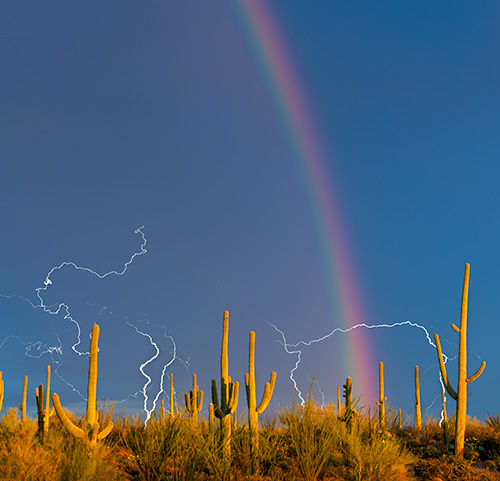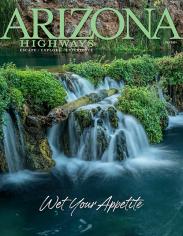A soft, lovely, righteous landscape, everything in proper order — not my Arizona! Give me complexity and contradiction and the murmur of menace. Give me this 4-mile trek along a canyon bottom, easy walking except for the stream fords with ominous nests of flash-flood flotsam over my head in the adjacent trees. The destination is Seven Falls, off the northeast tip of Tucson, where for just a couple of weeks in spring an ephemeral stream blooms from a canyon-side forest of saguaros and crashes into a rocky pool. A tumble of contradictions: desert, forest, waterfall. It upends any notion of easy coherence in nature. We have work ahead of us to comprehend it. Work ahead of us to coexist with it.
Among earthly landscapes, few feel more unearthly than the saguaro forest. The human interloper is greeted by tree-sized organisms that look not at all like trees. Bristling with defenses, they spin a storyline of ferocious fight for survival in a harsh environment — yet the Gila woodpeckers and elf owls, among numerous birds nesting in pecked-out caverns in the saguaro stem, suggest tolerant neighborliness. Relish the incongruities. Visit the saguaro forest at its eeriest: in a rare morning fog, or snow, or under the full moon. To experience the Earth’s strangest environments is to be most thoroughly alive.
The saguaro forest seems eerie not because these are strange plants, but because they don’t read like plants at all. They seem individualistic and expressive in a way plants cannot be — an alien race of sentient beings. “The limbs of the saguaro demand to be read as living gestures,” Reyner Banham wrote in Scenes in America Deserta. “They curl round in apparent embrace, touch as in prayer, are raised in surrender, point a rhetorical question, indicate some feature in the distance, or just stand as if in contemplation.” The saguaro seems so deeply alien that we can only explain its expressions in human metaphor.

Old saguaros exhibit the ravages of age in ways that all too easily remind us of our own slide into senescence. Decades of sunbathing turn their skin rough and dark. Relentless animal pecking and microbial assaults leave an ever-expanding array of scars. Arms fall off or droop uselessly after a deep freeze. At an age of 150 to 200 years, a senior saguaro will finally succumb to disease, drought, lightning or a developer. Young saguaros can be successfully transplanted out of the bulldozer’s way, but the elders — with all their nobility, wisdom and character — seldom survive being shoved aside.
A dead saguaro will often remain standing, its skin and pulp rotted away to leave just the skeleton propped against the desert sky. Sometimes these saguaro bones will assume a fantastic shape, like an elegant fountain’s spray or a mythical creature’s claw. The saguaro is as expressive in death as it is in life.
It is impossible to make a saguaro salt shaker, a throw pillow depicting a saguaro in a sunset, or a neon saguaro motel sign that does not land decisively in the category of “kitsch.” Even the camouflage saguaro cellphone towers that have arisen around Phoenix and Tucson, for all their good intentions, seem more comical than classy. Basic principle: The more imposing and spectacular a phenomenon of nature, the less likely we are to make credible imitations of it.
To have a shot at survival in the intense desert sun, a baby saguaro needs a “nurse plant” to provide shade until the cactus is large enough for its mass to moderate its internal heat gain. The paloverde tree, which provides lacy shade, is ideal. The saguaro will repay the favor by slowly killing its nurse as its spreading roots intercept an increasing share of the scarce water the tree needs. In turn, gilded flickers depend on saguaros for their nest cavities, and their particular modus of pecking out the cave can eventually kill the saguaro. As Emerson observed, “Nature ain’t no saint — but sometimes she does show a wickedly clever hand of justice.”
A saguaro can construct temporary roots within eight hours of a major rain to take rapid advantage. In a direct lightning hit, a rain-engorged saguaro can literally explode. A young-adult saguaro sips about 250 gallons of water a year. The average human resident of Tucson uses 27,740 gallons of water per year.
Every can of Old El Paso enchilada sauce cranked out by General Mills, which is based in Minneapolis, wears a label with a pair of saguaros one-sixteenth of an inch high. Saguaros do not grow in El Paso or anywhere in Texas, New Mexico or Minnesota. It’s not so much a case of cultural appropriation as it is that the saguaro has become a simplistic stand-in for “desert” or even “the West.” And we’re a little prickly, frankly, about seeing our iconic cactus both transplanted and trivialized.
A saguaro’s reproductive strategy depends on sprouting blossoms to attract birds, bats and bugs to fly its pollen to neighboring mates. Since blossoms arise only at the stem tip or the arms’ ends, a saguaro’s best shot at passing on its genes is to grow many arms. But this raises its risk of dying early, because the increased weight and windage may get it blown over in a storm. This leads one to a philosophical question about nature’s design, but not one that can be answered here: Why does sex have to be so risky?
Nature in Arizona does such outlandish things itself that it inspires, or perhaps provokes, outlandish adventures with it. In the summer of 1930, a 13-year-old Yuma boy named Lawrence Peters planted himself on a chair wedged high in the arms of a saguaro for five days, trying for a world cactus-sitting record. After 118 hours and 47 minutes, his parents ordered him down. The temperature was 112 degrees.
The “saguaro in a sunset” is the preeminent Arizona cliché, blazing from every license plate, postcard rack and Tumblr travelogue — and, inevitably, this issue of Arizona Highways. Back when I worked alongside photographer Jack Dykinga, at some point in the shoot, he’d invariably poke fun at himself, announcing, “Here’s the cliché shot.” Somehow it would still turn out to be brilliant. Dykinga’s online catalog now includes some 40 saguaro-in-a-sunset images. There’s a weirdly drooping arm bathed in red evening light. A lightning storm in the narrow band of daylight between land and sky. Saguaros-in-a-sunset in the snow. A moon rising over the saguaro forest just after dusk. Avoiding the cheesy cliché is easy: All you have to do is wait with infinite patience for the transcendent moment. And know what to do when it happens.

Last spring, the Arizona Game and Fish Department documented an eagle nest, complete with chicks, in the arms of a saguaro in Central Arizona. The siting of the nest looked remarkably similar to Lawrence Peters’ perch. It may have made more sense for the eagle family, which would have had substantially less trouble getting in and out.
A painstaking search of 150 years of Arizona newspaper archives reveals that the second-oddest thing anyone has done with a saguaro was clip off many thousands of spines and ship them to Chicago to become phonograph needles. This occurred in Tempe in 1914, and the dubiously reported consignment totaled 1,000 pounds. The oddest event occurred in 2017, when Tucson, hoping to win a large Amazon facility, tried to gift a 21-foot saguaro to Amazon CEO Jeff Bezos in Seattle — not a notably auspicious saguaro habitat. (Amazon rejected the gift, along with Tucson, and donated the saguaro to the Arizona-Sonora Desert Museum.)
Saguaros fit themselves to the Sonoran Desert with amazing precision. They visibly fatten with water storage during the summer monsoon or winter rains, then conserve it for sustenance through the seasonal droughts, with their skin expanding and contracting in folds, like an accordion. The spines not only repel hungry herbivores, but also provide the plant with filigreed shade for cooling in summer. The trumpet-like architecture of the saguaro flower is ideally proportioned for the long tongue of the lesser long-nosed bat, one of the cactus’ principal pollinators. For all our smarts, we humans have not designed anything that functions as agreeably in the desert as a saguaro.
We modern humans have capitalized on the saguaro for entertainment, but our predecessors in the Sonoran Desert had a more vital relationship with it. Traditional Tohono O’odham families had a winter home, a summer home and a cactus camp — the latter an early-summer migration to a saguaro forest to harvest its fruit. A ritual on the first day of camp illustrated the central importance of the saguaro to the culture: Each picker would open the first ripe fruit, rub its pulp over her heart and say a prayer of thanks for having lived another year. The harvested fruit would go on to yield jam, wine, vinegar, syrup and even seeds for chicken feed.
The saguaro might seem an unlikely building material, but the woody ribs are lightweight, rot-resistant and remarkably strong. Tohono O’odhams have used them for shade ramadas for centuries, and when Mexican and Anglo settlers began building adobe houses in Tucson, saguaro ribs were used as ceiling material to fill in the spaces between the support beams. They were strong enough to support the insulating layer of dirt above them.
People drifted into Southern Arizona before saguaros. Projectile points in a woolly mammoth kill site date to 13,000 years ago, late in the most recent ice age. Saguaros colonized Arizona only after the long cold snap ended about 8,000 years ago. For enthusiasts of our own species, this is reassuring: It suggests that we adapt to changing environments more easily. But what if our adaptations are threatening the saguaro?
First came the cattle: Starting in the late 19th century, cattle grazing on Southern Arizona ranch and federal lands erased a lot of the native grass that sheltered young saguaro seedlings from the sun, which later caused a decline in the census of mature saguaros. In the 20th century came poachers, capitalizing on the cactus’ popularity as a landscaping trophy. The apparent greatest threat here in the 21st century is a botanical invader, African buffelgrass, introduced for livestock forage. It competes with native plants for water and fuels grass fires that burn hot enough to kill saguaros. The warming climate can also directly affect saguaros, reducing the enzyme efficiency that powers their photosynthesis. Looking at the underlying architecture of all the saguaros’ problems, it’s apparent that the most problematic invasive species is … us.
Is the saguaro in real danger of retreat, or even extinction? Predictions of its doom, imminent or eventual, have circulated periodically since the 1940s and have so far been proved wrong. The only answer at this point is: It’s uncertain. In some study areas, seedlings and young plants have been in decline since the 1990s. The fire situation is unquestionably becoming more critical. On the positive side, botanists are beginning to see saguaros thriving on north-facing mountain slopes as an adaptation to climate change. And conservation efforts, now nearly a century old, have made a real difference. The saguaros’ best hope is the same as their greatest threat. Again, it’s … us.

